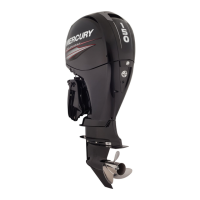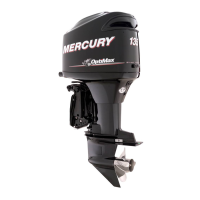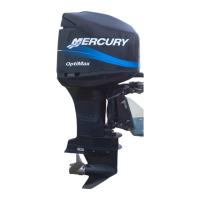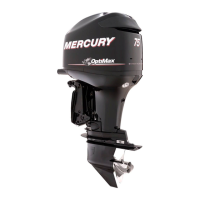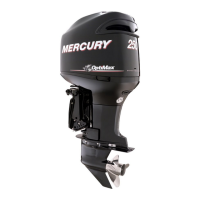GENERAL INFORMATION
90-855347R1 JANUARY 1999 Page 1C-3
To obtain optimum engine performance under changing weather conditions, the engine
MUST be propped to allow it to operate at or near the top end of the recommended maxi-
mum RPM range at wide-open-throttle with a normal boat load.
This will allow the engine to develop full power while operating in an RPM range that dis-
courages damaging detonation.
Boat
WEIGHT DISTRIBUTION
1. Proper positioning of the weight inside the boat (persons and gear) has a significant
effect on the boat’s performance, for example:
a. Shifting weight to the rear (stern)
(1.)Generally increases top speed.
(2.)If in excess, can cause the boat to porpoise.
(3.)Can make the bow bounce excessively in choppy water.
(4.)Will increase the danger of the following wave splashing into the boat when
coming off plane.
b. Shifting weight to the front (bow)
(1.)Improves ease of planing off.
(2.)Generally improves rough water ride.
(3.)If excessive, can make the boat veer back-and-forth (bow steer).
BOTTOM
1. Boat Bottom: For maximum speed, a boat bottom should be nearly a flat plane where
it contacts the water and particularly straight and smooth in fore-and-aft direction.
a. Hook: Exists when bottom is concave in fore-and -aft direction when viewed from
the side. When boat is planing, “hook” causes more lift on bottom near transom
and allows bow to drop, thus greatly increasing wetted surface and reducing boat
speed. “Hook” frequently is caused by supporting boat too far ahead of transom
while hauling on a trailer or during storage.
b. Rocker: The reverse of hook and much less common. “Rocker” exists if bottom
is convex in fore-and-aft direction when viewed from the side, and boat has strong
tendency to porpoise.
c. Surface Roughness: Moss, barnacles, etc., on boat or corrosion of motor’s gear
housing increase skin friction and cause speed loss. Clean surfaces when neces-
sary.
d. Gear Housing: If unit is left in the water, marine vegetation may accumulate over
a period of time. This growth MUST be removed from unit before operation, as it
may clog the water inlet holes in the gear housing and cause the engine to over-
heat.

